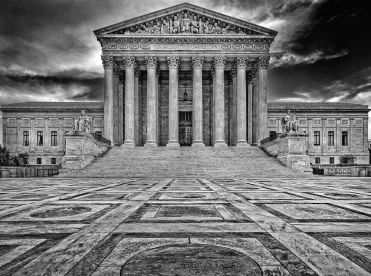The Supreme Court of the United States (Justice Breyer writing for the majority) affirmed a US Court of Appeals for the Federal Circuit decision barring judicial review of most decisions regarding institution of inter partes review (IPR) by the US Patent and Trademark Office (PTO) and authorizing the PTO to construe a patent claim in IPR according to the broadest reasonable interpretation (BRI) standard. The Supreme Court held that the statutory text forbids most appeals regarding the institution decision, and that the statute grants the PTO the authority to determine the standard for claim construction in IPR. Cuozzo Speed Techs., LLC v. Lee, Case No. 15-446 (US, June 20, 2016) (Breyer, J) (Thomas, J, concurring) (Alito, J, concurring in part and dissenting in part, joined by Sotomayor, J).
Background
Cuozzo is the owner of a patent directed to a speedometer that shows a driver when the vehicle’s speed exceeds the speed limit. Garmin filed a petition seeking IPR of all 20 of the patent’s claims. Garmin’s petition described how claim 17 of the patent was obvious in light of prior art references, and the Patent Trial and Appeal Board (PTAB or Board) agreed to reexamine claim 17, along with claims 10 and 14. While the petition had not expressly challenged claims 10 and 14 on the same grounds as claim 17, claim 17 was dependent on claim 14, which was dependent on claim 10. Therefore, the PTAB reasoned that Garmin had implicitly challenged claims 10 and 14, and eventually issued a final written decision finding claims 10, 14 and 17 invalid as obvious. Cuozzo appealed.
On appeal, Cuozzo argued that the PTAB improperly instituted review at least with respect to claims 10 and 14 because Garmin had not expressly challenged those claims on the grounds on which the PTAB instituted review. Cuozzo also argued that the PTAB improperly construed the claims according to the BRI standard, when it should have applied the standard used in district courts, where claims are given their ordinary meaning as understood by a person of skill in the art.
The Federal Circuit rejected both of Cuozzo’s arguments, finding that the statutory text renders the decision on institution “nonappealable,” and that the application of the BRI standard was a reasonable, and hence lawful, exercise of the PTO’s statutorily granted rulemaking authority. Cuozzo then petitioned the Supreme Court for certiorari, which was granted (IP Update, Vol. 19, No. 1).
Institution Decisions Are Final and Not Appealable
The Supreme Court agreed with the Federal Circuit that the decision on institution is not appealable here. First, the statute expressly states that the PTO’s determination on institution is “final and nonappealable.” Second, the dispute at issue, involving a legal question of whether the petition was pleaded “with particularity,” is the kind of issue that must be forbidden by the statute’s unambiguous language. While the Supreme Court recognized that there is a strong presumption in favor of judicial review, this presumption may be overcome by clear statutory text. Even so, the Supreme Court emphasized that its holding applies only to grounds for attacking the institution decision that are tied to the application and interpretation of the statute. Specifically, constitutional challenges are not addressed.
Use of BRI Standard Is Reasonable
The Supreme Court also agreed with the Federal Circuit that the statute gives the PTO the legal authority to construe claims according to the BRI standard. The Supreme Court found that the statute does not unambiguously direct the PTO to use one claim construction standard or the other; hence the agency has leeway to enact rules that are reasonable in light of the text, nature and purpose of the statute.
The Supreme Court explained that adopting the BRI standard is a reasonable exercise of the PTO’s rulemaking authority and that the BRI standard encourages the applicant to draft the claim narrowly, protecting the public from overly broad claims while encouraging disclosure enabling the public to better understand the lawful limits of the claim. In addition, the Supreme Court noted that the PTO has used the BRI standard for more than 100 years.
The Dissent
In dissent, Justice Alito (joined by Justice Sotomayor) found that the PTO’s decision on institution of an IPR proceeding should be subject to judicial review. Alito noted that the Supreme Court applies a strong presumption favoring judicial review of administrative action, and interpreted the statutory language to bar interlocutory appeals of the institution decision, while allowing review of institution-related issues in an appeal from the PTO’s final written decision.
Practice Note
The majority opinion forecloses most legal and factual challenges to decisions on institution, but constitutional challenges remain. Additional guidance may be forthcoming in two upcoming cases challenging the constitutionality of post-grant proceedings, both of which are currently being briefed before the Supreme Court: Cooper v. Lee and MCM Portfolio LLC v. Hewlett-Packard Co.(IP Update, Vol. 19, No. 1). In the wake of its decision in Cuozzo, the Supreme Court grantedcertiorari in Click-To-Call Techs., LP v. Oracle Corp., Case No. 15-1014 (June 27, 2016), a case pertaining to appellate review of PTAB decisions, and vacated and remanded the case back to the Federal Circuit for reconsideration in view of Cuozzo.




 />i
/>i

